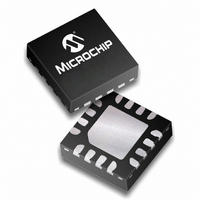PIC16F688-E/ML Microchip Technology, PIC16F688-E/ML Datasheet - Page 257

PIC16F688-E/ML
Manufacturer Part Number
PIC16F688-E/ML
Description
IC PIC MCU FLASH 4KX14 16QFN
Manufacturer
Microchip Technology
Series
PIC® 16Fr
Datasheets
1.PIC16F616T-ISL.pdf
(8 pages)
2.PIC16F688T-ISL.pdf
(204 pages)
3.PIC16F688T-ISL.pdf
(6 pages)
4.PIC16F688T-ISL.pdf
(4 pages)
5.PIC16F688T-ISL.pdf
(688 pages)
Specifications of PIC16F688-E/ML
Core Size
8-Bit
Program Memory Size
7KB (4K x 14)
Core Processor
PIC
Speed
20MHz
Connectivity
UART/USART
Peripherals
Brown-out Detect/Reset, POR, WDT
Number Of I /o
12
Program Memory Type
FLASH
Eeprom Size
256 x 8
Ram Size
256 x 8
Voltage - Supply (vcc/vdd)
2 V ~ 5.5 V
Data Converters
A/D 8x10b
Oscillator Type
Internal
Operating Temperature
-40°C ~ 125°C
Package / Case
16-QFN
Controller Family/series
PIC16F
No. Of I/o's
12
Eeprom Memory Size
256Byte
Ram Memory Size
256Byte
Cpu Speed
20MHz
No. Of Timers
2
Processor Series
PIC16F
Core
PIC
Data Bus Width
8 bit
Data Ram Size
256 B
Interface Type
EUSART, RS- 232, SCI, USB
Maximum Clock Frequency
20 MHz
Number Of Programmable I/os
12
Number Of Timers
2
Maximum Operating Temperature
+ 125 C
Mounting Style
SMD/SMT
3rd Party Development Tools
52715-96, 52716-328, 52717-734
Development Tools By Supplier
PG164130, DV164035, DV244005, DV164005, PG164120, ICE2000, DM163014, DM164120-4
Minimum Operating Temperature
- 40 C
On-chip Adc
10 bit, 8 Channel
Lead Free Status / RoHS Status
Lead free / RoHS Compliant
For Use With
AC164324 - MODULE SKT FOR MPLAB 8DFN/16QFNXLT16QFN1 - SOCKET TRANSITION 14DIP TO 16QFNAC162061 - HEADER INTRFC MPLAB ICD2 20PINAC162056 - HEADER INTERFACE ICD2 16F688
Lead Free Status / Rohs Status
Details
- PIC16F616T-ISL PDF datasheet
- PIC16F688T-ISL PDF datasheet #2
- PIC16F688T-ISL PDF datasheet #3
- PIC16F688T-ISL PDF datasheet #4
- PIC16F688T-ISL PDF datasheet #5
- Current page: 257 of 688
- Download datasheet (3Mb)
1997 Microchip Technology Inc.
The SSP consists of a transmit/receive Shift Register (SSPSR) and a Buffer register (SSPBUF).
The SSPSR shifts the data in and out of the device, MSB first. The SSPBUF holds the data that
was previously written to the SSPSR, until the received data is ready. Once the 8-bits of data
have been received, that information is moved to the SSPBUF register. Then the buffer full detect
bit, BF (SSPSTAT <0>), and interrupt flag bit, SSPIF, are set. This double buffering of the received
data (SSPBUF) allows the next byte to start reception before reading the data that was received.
Any write to the SSPBUF register during transmission/reception of data will be ignored, and the
write collision detect bit, WCOL (SSPCON<7>), will be set. User software must clear the WCOL
bit so that it can be determined if the following write(s) to the SSPBUF register completed suc-
cessfully. When the application software is expecting to receive valid data, the SSPBUF should
be read before the next byte of data to transfer is written to the SSPBUF. Buffer full bit, BF (SSP-
STAT<0>), indicates when SSPBUF has been loaded with the received data (transmission is
complete). When the SSPBUF is read, the BF bit is cleared. This data may be irrelevant if the SPI
is only a transmitter. Generally the SSP Interrupt is used to determine when the transmis-
sion/reception has completed. The SSPBUF can then be read (if data is meaningful) and/or the
SSPBUF (SSPSR) can be written. If the interrupt method is not going to be used, then software
polling can be done to ensure that a write collision does not occur.
ing of the SSPBUF (SSPSR) for data transmission. The shaded instruction is only required if the
received data is meaningful (some SPI applications are transmit only).
Example 16-1: Loading the SSPBUF (SSPSR) Register
The SSPSR is not directly readable or writable, and can only be accessed from addressing the
SSPBUF register. Additionally, the SSP status register (SSPSTAT) indicates the various status
conditions.
LOOP BTFSS SSPSTAT, BF
BCF
BSF
GOTO
BCF
MOVF
MOVWF RXDATA
MOVF
MOVWF SSPBUF
STATUS, RP1
STATUS, RP0
LOOP
STATUS, RP0
SSPBUF, W
TXDATA, W
;Specify Bank1
;
;Has data been received (transmit complete)?
;No
;Specify Bank0
;W reg = contents of SSPBUF
;Save in user RAM, if data is meaningful
;W reg = contents of TXDATA
;New data to xmit
Section 16. BSSP
Example 16-1
DS31016A-page 16-7
shows the load-
16
Related parts for PIC16F688-E/ML
Image
Part Number
Description
Manufacturer
Datasheet
Request
R

Part Number:
Description:
Manufacturer:
Microchip Technology Inc.
Datasheet:

Part Number:
Description:
IC PIC MCU FLASH 4KX14 14SOIC
Manufacturer:
Microchip Technology
Datasheet:

Part Number:
Description:
IC MCU FLASH 4KX14 14TSSOP
Manufacturer:
Microchip Technology
Datasheet:

Part Number:
Description:
IC PIC MCU FLASH 4KX14 14DIP
Manufacturer:
Microchip Technology
Datasheet:

Part Number:
Description:
IC PIC MCU FLASH 4KX14 16QFN
Manufacturer:
Microchip Technology
Datasheet:

Part Number:
Description:
IC MCU PIC FLASH 4KX14 14SOIC
Manufacturer:
Microchip Technology
Datasheet:

Part Number:
Description:
IC PIC MCU FLASH 4KX14 14TSSOP
Manufacturer:
Microchip Technology
Datasheet:

Part Number:
Description:
IC MCU PIC FLASH 4KX14 14DIP
Manufacturer:
Microchip Technology
Datasheet:

Part Number:
Description:
IC PIC MCU FLASH 4KX14 14TSSOP
Manufacturer:
Microchip Technology
Datasheet:

Part Number:
Description:
IC, 8BIT MCU, PIC16F, 32MHZ, SOIC-18
Manufacturer:
Microchip Technology
Datasheet:

Part Number:
Description:
IC, 8BIT MCU, PIC16F, 32MHZ, SSOP-20
Manufacturer:
Microchip Technology
Datasheet:

Part Number:
Description:
IC, 8BIT MCU, PIC16F, 32MHZ, DIP-18
Manufacturer:
Microchip Technology
Datasheet:

Part Number:
Description:
IC, 8BIT MCU, PIC16F, 32MHZ, QFN-28
Manufacturer:
Microchip Technology
Datasheet:

Part Number:
Description:
IC, 8BIT MCU, PIC16F, 32MHZ, QFN-28
Manufacturer:
Microchip Technology
Datasheet:

Part Number:
Description:
IC, 8BIT MCU, PIC16F, 32MHZ, QFN-28
Manufacturer:
Microchip Technology
Datasheet:










